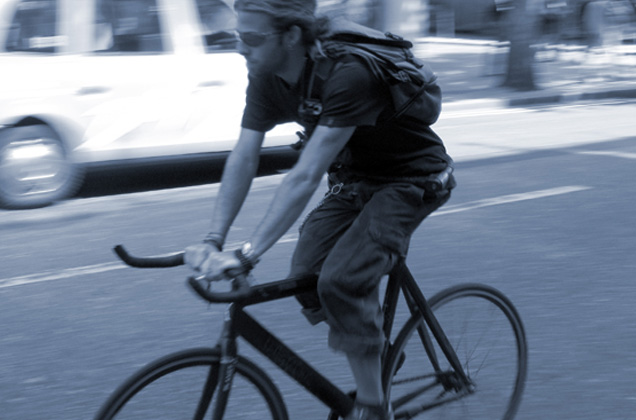Towns are becoming more and more congested with cars, but cycling offers a relatively cheap and practical alternative.
Cycling in town often gets you where you want to be faster than driving. You won’t be held up by traffic jams, and finding parking space is no longer a burning issue. Cycling is also an ecological alternative to the car. You don’t burn gas or fuel, instead you burn calories, which will help you maintain or improve your physical fitness.
Choose your bike
The type of bike you choose depends on the use you want to make of it, the distance you have to ride, whether you have to transport luggage etc. If you are a serious rider you may want to invest in a good bike. If you want to use it only for commuting a second hand bike may be all you need.
A racing bike is suitable if you have to do a fairly long distance – if the average road conditions are good and if you want to cycle fast. The gears on a racing bike allow you to take on hilly roads as well as flat ones. A racing bike, however, is not built to be comfortable. Although you sit up high on your bike, the ‘racing’ position may not give you the best view of traffic. The narrow handlebars give you less control during slower manoeuvres.
An all-terrain bike (ATB) has a larger handle bar, allows a slightly more upright position and may give you a better position to ride in the city traffic. It normally has more gears than on a racing bike and will allow you to climb even steep roads more easily. Full all-terrain tyres are not needed if you use your bike mainly for road use. Tyres with a mixed profile and slicks (no profile at all) can significantly improve the ride on the road.
A hybrid bike offers the best of both worlds, boasting the wheel size of a racing bike and slightly fatter tyres, usually with a road-adapted profile, allowing you to ride somewhat faster than on an ATB. On the other hand, the riding position is high like the racing bike, but somewhat more upright, making it more comfortable and allowing you a better view of the road. The handle bars are comparable to an ATB, large and allowing a lot of control, even at lower speeds. Also, the gears are comparable to an all-terrain bike, allowing you to climb the steeper roads more easily.
On all three types of bikes it is possible to mount fenders (to protect you against water and mud), luggage racks and lights.
A ‘fixie’ (fixed-gear bicycle) is a trendy vehicle, associated with the urban cycling in-crowd, but it is probably not the best choice if you want a versatile bike. This type of bike is suitable for experienced cyclists only. A fixie is based on a track racing bike, has a fixed rear chain wheel (like on a spinning bike, hence the name fixie), only one gear and only an emergency front brake. Fixies are often built from exotic bike parts and are usually custom-made (though recently several manufacturers offer new, great looking fixies). A fixie requires leg power (no gears), control (no brakes) and excellent anticipation in traffic. Fenders and luggage possibilities are not taken into account.
The single speed bike is also a very trendy, but safer alternative to the fixie. These bikes are similar to fixies. It has only one gear but boasts freewheel and brakes, requiring leg power and cycling skills – those brakes and freewheel make it less of a specialist bike than the fixie.
Ride safely
Take care of your bike and make sure it is in a good working condition. The brakes have to function well, and wheels need to be well fixed, undamaged and mounted with the right tyres. Inflate your tyres at the correct pressure. Be visible by wearing a fluorescent vest over your normal clothes, and if you carry a rucksack, put a fluorescent cover over it.
Fluorescent arm and ankle straps increase your visibility, too. It’s true that you may sometimes look like a Christmas tree, but better that than being struck by a car.
When you ride when it is dark and/or in conditions with only limited visibility such as rain or fog, make sure that lights on your bike are working properly.
Remember that you are not surrounded by a protective cage, so respect the traffic rules and be aware of what happens around you.
Protective gear
Wear a crash helmet. Bike helmets have evolved enormously. Nowadays, they are light, well vented and often easy to adapt to the size of your head.
Glasses protect your eyes from sunlight, dust and insects. Specific glasses for cycling (and other sports) surround your face and usually sit slightly above eyebrow level, protecting your eyes when you are slightly bent over. The lenses of sports glasses are often interchangeable, useful when you ride in foggy conditions.
Protect your bike
Make sure if you have a good bike that you can keep it indoors, and, even then, make sure to put a good lock on it. It’s best to pass the chain or lock through the front wheel and frame and then attach it to something (traffic sign, tree etc). Avoid cheap cable locks and number code locks, since they are easy to break. The best locks are U locks, or big solid chains with a good lock. It will add weight to your bike, but that’s better than having a weightless bike because it was stolen.
Traffic behaviour
Claim your place in the traffic. Don’t ride too close to the sidewalks – be where car drivers are able to see you. Also, keep a safe distance from parked cars in order not to be surprised by doors that are suddenly opened by careless drivers.
When you are on a bicycle path, make sure car drivers have noticed you when they take a turn. They may not have seen you if many parked cars are placed between the driving lane and the cycle path. If you are sufficiently confident, it may sometimes be a better idea not to take to the cycle path, but ride visibly on the main road. When you take a turn, look behind you, indicate with your arm which direction you go, look behind again and then turn.
To sum up: If you have the right material and adopt the correct behaviour on the road, you will find that cycling is a very good option for commuting in town. Brussels is not particularly flat, so for those who want to start easily or simply hate cycling uphill, take your bike with you in trams and metros at certain hours and cycle only on the flat and downhill. But, whatever the bike or wherever you ride, enjoy!







